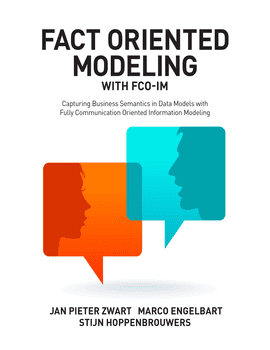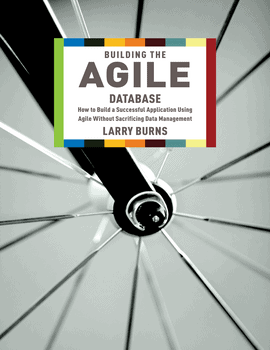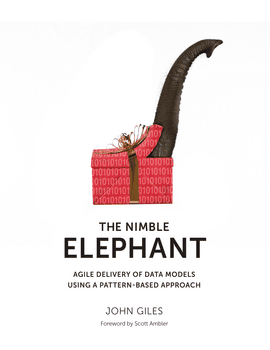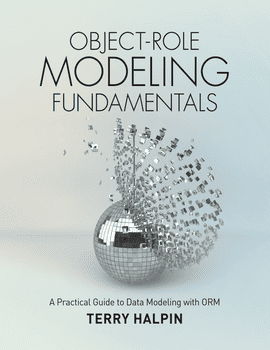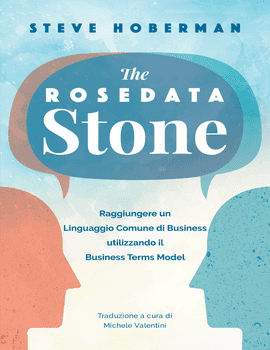Fact Oriented Modeling
Fact Oriented Modeling with FCO-IM: Capturing Business Semantics in Data Models with Fully Communication Oriented Information Modeling, by Jan Pieter Zwart, Marco Engelbart, and Stijn Hoppenbrouwers
This book offers a complete basic course in Fully Communication Oriented Information Modeling (FCO-IM), a Fact Oriented Modeling (FOM) data modeling technique. The book is suitable for self-study by beginner FCO-IM modelers, whether or not experienced in other modeling techniques. An elaborate case study is used as illustration throughout the book.
Topics
Chapter 1: Information Modeling in Context
1.1 Business Information and Communication Systems
1.2 Views on Business Communication
1.2.1 Information Model
1.2.2 Business Vocabulary
1.2.3 Graphical User Interface (GUI)
1.2.4 Business Process Model
1.2.5 Business Rules
1.2.6 Use Cases
1.2.7 Summary of Views
1.3 Fact Oriented Modeling (FOM)
1.3.1 Hallmarks of FOM Techniques
1.3.1.1 Verbalizations of Concrete Examples of Facts
1.3.1.2 A Good Procedure for How to Model
1.3.1.3 Focus on Elementary Facts
1.3.2 What Makes FCO-IM Special?
1.3.2.1 Crucial Distinction between FCO-IM and Other FOM Techniques
1.4 Why This Book?
Chapter 2: Serviceton Music Theater
2.1 Description of the Domain
2.2 The Information System Development Perspective
2.2.1 Serviceton Music Theater Business Process Model
2.2.2 Serviceton Music Theater Use Case Diagram and Brief Description
2.2.3 Serviceton Music Theater Graphical User Interface
2.2.4 Serviceton Music Theater Information Model
2.2.5 Serviceton Music Theater Business Rules
Chapter 3: How to Model the Facts
3.1 The FCO-IM Information Modeling Procedure
3.2 Collecting: Finding or Drawing up Examples of Facts
3.3 Verbalizing: Putting the Concrete Examples Into Words
3.3.1 Why Verbalize?
3.3.2 Good Verbalizations for Serviceton
3.3.3 Guidelines for Verbalizing
3.3.3.1 Express Concrete Facts That Can Be Highlighted
3.3.3.2 Express Exactly One Fact: No Clusters of Facts, No Incomplete Facts
3.3.3.3 Use Sentences That Do Not Depend on Other Sentences
3.3.3.4 Use Sentences That Make the Meaning of the Facts as Clear as Possible
3.4 Sorting
3.4.1 Verbalizations for Serviceton
3.4.2 Sorting: Typing and Naming
3.5 Reading Back Fact Expressions From an FCO-IM Diagram
3.5.1 Fact, Fact Type, Role, Fact Expression, Fact Expression Type
3.5.2 Tuple, Population
3.5.3 Object, Object Type, Object Expression, Object Expression Type
3.5.4 Label, Label Type
3.5.5 Reading Back the Complete Fact Expressions
3.6 Analyzing
3.6.1 Analyzing Fact Type ‘Show’
3.6.2 Rule of Thumb and Procedure for Analyzing
3.6.3 Analyzing Fact Type ‘Performance Features Show’
3.6.4 Analyzing Fact Type ‘Performance PRICE’
3.6.5 Summary of Analyzing the other Performance Schedule Fact Types
3.6.6 Dos and Don’ts When Analyzing
3.6.6.1 Dos When Analyzing
3.6.6.2 Don’ts When Analyzing
3.6.7 An Object Expression Must be a Connected Sentence Part
Chapter 4: How to Keep the Facts Sound Using Constraints
4.1 Introduction to Business Rules and Constraints
4.1.1 Stating Business Rules and Constraints
4.2 Uniqueness Constraints (UCs)
4.2.1 Illustrations of how Uniqueness Constraints are Determined
4.2.2 Procedure to Find all UCs in an Information Model
4.2.3 Procedure Applied to Fact Types With Three Roles
4.2.3.1 First Example
4.2.3.1 Second Example
4.2.4 Summary of Determining UCs for the Remaining FTs of the Performance Schedule
4.3 Totality Constraints (TCs)
4.3.1 Illustrations of How Totality Constraints are Determined
4.3.2 Procedure to Find all TCs in an Information Model
4.3.2.1 Attribute Fact Type and Own Attribute Fact Type
4.3.2.2 Typical Cases
4.3.3 Summary of Determining TCs for the Remaining FTs of the Performance Schedule
4.4 Value Constraints (VCs)
4.4.1 Value Constraint or Domain List?
4.4.2 Procedure to Find all VCs in an Information Model
4.4.3 Summary of Determining VCs for the Remaining FTs of the Performance Schedule
4.5 Other Constraints
4.5.1 Totality Constraint on two out of Many Roles
4.5.2 Subset Constraint Between two Roles
4.5.3 Equality Constraint Between two or More Roles
4.5.4 Cardinality Constraint With Value Requirement
4.5.5 Uniqueness Constraint Between two Fact Types
4.5.6 Circular Constraint
4.5.7 Dynamic Constraint
4.5.8 Deontic Totality Constraint on a Role
Chapter 5: How to Check your Model and get it Approved
5.1 Verbalizations are Crucial to Verify and Validate the Model
5.2 Form Rules for an FCO-IM Diagram
5.2.1 Naming Conventions
5.2.2 Requirements for Fact Expression Types and Object Expression Types
5.3 Is the model really elementary?
5.3.1 N Rule
5.3.2 N-1 Rule
5.3.3 When to Perform the N Rule and N-1 Rule Tests
5.4 Was any Object Type Overlooked?
5.4.1 Example of Overlooked Object Type in Serviceton Theater
5.4.2 General Pattern Revealing an Overlooked Object Type
5.4.3 When to Perform the Overlooked Object Type Test and add a new Object Type
Chapter 6: Advanced Topics
6.1 Alternative Ways to Model the Same Fact Expressions
6.1.1 Different Way of Sorting: Different Table Structures
6.1.1.1 Different Fact Types if Only a Few Fixed Values Exist
6.1.1.2 Consequences for the Information Model and Table Structure
6.1.1.3 Pros and Cons of These Two Alternatives
6.1.1.4 Advice to Choose Between These Two Ways of Modeling
6.1.2 General Advice on Modeling: as Data Instead of Metadata
6.1.3 Different Way of Analyzing: Extra Object Type
6.1.3.1 Recognizing an Extra Object Type
6.1.3.2 Two ‘Extra’ Object Types That are the Same Must be United
6.2 Some Things are Special: Introduction to Subtypes
6.2.1 Declarative and Derivable Subtypes
6.2.1.1 Declarative Subtype
6.2.1.2 Derivable Subtype
6.2.2 Difference Between Subtypes and ‘Ordinary’ Object Types
6.2.2.1
6.2.2.2
6.3 A Window on Further Modeling Power
Chapter 7: Model Transformations
7.1 Transformation of an FCO-IM IGD Into a Relational Database Schema
7.1.1 What is a Relational Database, Really?
7.1.2 Derivation of a Relational Schema: Indicating Tables in the IGD
7.1.2.1 Placing Fact Types Together in one Table
7.1.2.2 Visualizing Tables in an IGD
7.1.3 Derivation of a Relational Schema: Group, Lexicalize, Reduce and Convert
7.1.3.1 Group
7.1.3.2 Lexicalize
7.1.3.3 Reduce
7.1.3.4 Convert: The Resulting Relational Database Schema
7.2 Transformation of an FCO-IM IGD Into an Entity Relationship Diagram
7.2.1 Step 1
7.2.2 Step 2
7.3 Transformation of an FCO-IM IGD Into Other Modeling Techniques
Chapter 8: Perspectives on Information Modeling
8.1 Business Support
8.2 Business Processes, Business Rules
8.3 Semantic Web (Machine Readability, AI, Rules, Ontology)
8.4 Interoperability (Ontologies, Standards, Diversity)
8.5 Quality of Data, Quality of Information, Data Governance
8.6 Business Intelligence, Data Warehousing
8.7 Big Data, NoSQL, Analytics
8.8 Links with Other Modeling Schools
8.9 System Generation, Model-Based Development, Evolutionary Systems
8.10 Alternative Uses of FOM
The book also illustrates how data models in other techniques can be derived from an elementary FCO-IM model. The context of fact oriented modeling is given as well, and perspectives on information modeling indicate related areas of application and further reading.
Fact Oriented Modeling methods (like FCO-IM) have three major advantages over other data modeling techniques:
- FCO-IM captures business semantics. The meaning of facts is captured by incorporating into the model expressions of concrete facts in clear sentences, which are understood by both domain experts and information modelers.
- FCO-IM includes a detailed working procedure that tells you exactly how to make a data model. Many techniques are clear about what is to be modeled, but few offer a detailed set of guidelines and checks that tell you how to draw up, check and validate your model.
- FCO-IM focuses on elementary facts, avoiding premature clustering of facts (in entities) but also avoiding considering only incomplete fragments of facts (attributes). From an elementary model, data models in other techniques can be automatically derived (ERM, UML, Data Vault, Star Schema, and Relational and NoSQL databases).
About Jan, Marco, and Stijn
Jan Pieter Zwart (1955) is assistant professor of Information Systems at HAN University of Applied Sciences (HAN UAS, Arnhem, the Netherlands). He has been active as teacher and developer in the field of conceptual information modeling and metadata driven transformations since 1985. He is co-author of the first book on FCO-IM, and has published peer-reviewed papers on further developments in FCO-IM. Jan Pieter divides his time between teaching and doing research in the fundamentals of data and process models in the Model-Based Information Systems group at HAN UAS.
Marco Engelbart (1964) is assistant professor in Information Technology at HAN University of Applied Sciences (Arnhem, the Netherlands). He has over 25 years of experience in teaching conceptual information modeling and other subjects related to information systems development and software engineering. Marco is co-author of the FCO-IM exercise book (in Dutch). As member of the Model-Based Information Systems research group at HAN UAS he is actively involved in designing transformation algorithms for model transformations from FCO-IM to Data Vault and Anchor Modeling.
Stijn Hoppenbrouwers PhD (1970) is professor of Information Systems at HAN University of Applied Sciences (Arnhem, the Netherlands) and assistant professor at Radboud University (Nijmegen, the Netherlands). He has published over 100 peer-reviewed papers at international conferences and in journals, on Conceptual Modeling, Requirements Engineering, Collaborative Modeling, Enterprise Engineering, and Method Engineering. He was a member of the team designing the ArchiMate language for Enterprise Modeling. Stijn currently leads the Model-Based Information Systems research group at HAN UAS and heads the HAN Center for IT and Media. Stijn teaches at HAN, at Radboud University, and at international events and summer schools.
Faculty may request complimentary digital desk copies
Please complete all fields.
